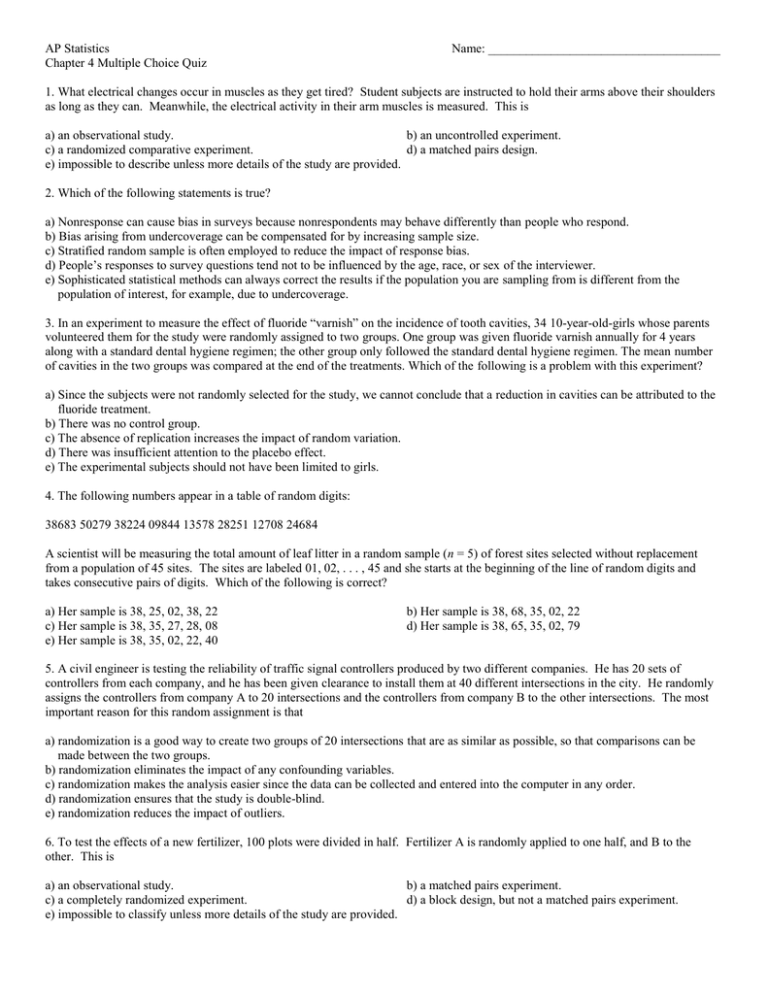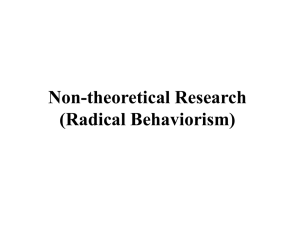AP Statistics Chapter 4 Quiz: Experimental Design & Sampling
advertisement

AP Statistics Chapter 4 Multiple Choice Quiz Name: _____________________________________ 1. What electrical changes occur in muscles as they get tired? Student subjects are instructed to hold their arms above their shoulders as long as they can. Meanwhile, the electrical activity in their arm muscles is measured. This is a) an observational study. b) an uncontrolled experiment. c) a randomized comparative experiment. d) a matched pairs design. e) impossible to describe unless more details of the study are provided. 2. Which of the following statements is true? a) Nonresponse can cause bias in surveys because nonrespondents may behave differently than people who respond. b) Bias arising from undercoverage can be compensated for by increasing sample size. c) Stratified random sample is often employed to reduce the impact of response bias. d) People’s responses to survey questions tend not to be influenced by the age, race, or sex of the interviewer. e) Sophisticated statistical methods can always correct the results if the population you are sampling from is different from the population of interest, for example, due to undercoverage. 3. In an experiment to measure the effect of fluoride “varnish” on the incidence of tooth cavities, 34 10-year-old-girls whose parents volunteered them for the study were randomly assigned to two groups. One group was given fluoride varnish annually for 4 years along with a standard dental hygiene regimen; the other group only followed the standard dental hygiene regimen. The mean number of cavities in the two groups was compared at the end of the treatments. Which of the following is a problem with this experiment? a) Since the subjects were not randomly selected for the study, we cannot conclude that a reduction in cavities can be attributed to the fluoride treatment. b) There was no control group. c) The absence of replication increases the impact of random variation. d) There was insufficient attention to the placebo effect. e) The experimental subjects should not have been limited to girls. 4. The following numbers appear in a table of random digits: 38683 50279 38224 09844 13578 28251 12708 24684 A scientist will be measuring the total amount of leaf litter in a random sample (n = 5) of forest sites selected without replacement from a population of 45 sites. The sites are labeled 01, 02, . . . , 45 and she starts at the beginning of the line of random digits and takes consecutive pairs of digits. Which of the following is correct? a) Her sample is 38, 25, 02, 38, 22 c) Her sample is 38, 35, 27, 28, 08 e) Her sample is 38, 35, 02, 22, 40 b) Her sample is 38, 68, 35, 02, 22 d) Her sample is 38, 65, 35, 02, 79 5. A civil engineer is testing the reliability of traffic signal controllers produced by two different companies. He has 20 sets of controllers from each company, and he has been given clearance to install them at 40 different intersections in the city. He randomly assigns the controllers from company A to 20 intersections and the controllers from company B to the other intersections. The most important reason for this random assignment is that a) randomization is a good way to create two groups of 20 intersections that are as similar as possible, so that comparisons can be made between the two groups. b) randomization eliminates the impact of any confounding variables. c) randomization makes the analysis easier since the data can be collected and entered into the computer in any order. d) randomization ensures that the study is double-blind. e) randomization reduces the impact of outliers. 6. To test the effects of a new fertilizer, 100 plots were divided in half. Fertilizer A is randomly applied to one half, and B to the other. This is a) an observational study. b) a matched pairs experiment. c) a completely randomized experiment. d) a block design, but not a matched pairs experiment. e) impossible to classify unless more details of the study are provided. 7. An airline that wants to assess customer satisfaction chooses a random sample of 10 of its flights during a single month and asks all of the passengers on those flights to fill out a survey. This is an example of a a) multistage sample. c) cluster sample. e) convenience sample. b) stratified sample. d) simple random sample. 8. You work for an advertising agency that is preparing a new television commercial to appeal to women. You have been asked to design an experiment to compare the effectiveness of three versions of the commercial. Each subject will be shown one of the three versions and then asked her attitude toward the product. You think there may be large differences between women who are employed outside the home and those who are not. Because of these differences, you should use a) a completely randomized design. c) a block design. e) a multistage sample. b) a categorical variable. d) a stratified design. 9. According to the 1990 census, those states with an above-average number of people X, who fail to complete high school tend to have an above average number of infant deaths, Y. In other words, there is a positive association between X and Y. The most plausible explanation for this is a) X causes Y. Programs to keep teens in school will help reduce the number of infant deaths. b) Y causes X. Programs that reduce infant deaths will ultimately reduce high school dropouts. c) Other variables may be confounded with variable X. For example, states with large populations may have both larger numbers of people who don’t complete high school and more infant deaths. d) Both of these variables are directly affected by the higher incidence of cancer in certain states. e) The association between X and Y is purely coincidental. 10. Eighty volunteers who currently use a certain brand of over-the-counter allergy medication have been recruited to participate in a trial of a new allergy medication. The volunteers are randomly assigned to one of two groups. One group continues to take their current medication, the other group switches to the new experimental medication. Each is asked after two weeks if their allergy symptoms are worse, better, or about the same as they were at the start of the study. Which of the follow best describes a conclusion that can be drawn from this study? a) We can determine whether the new drug reduces symptoms more than the old drug for anyone who suffers from allergies. b) We can determine whether the new drug reduces symptoms more than the old drug for the subjects in the study. c) We can determine whether the allergies sufferers’ symptoms improved more with the new drug than with the old drug, but we can’t establish cause and effect. d) We cannot draw any conclusions, since all the volunteers were already taking the old drug when the experiment started. e) We cannot draw any conclusions, because there was no control group.







